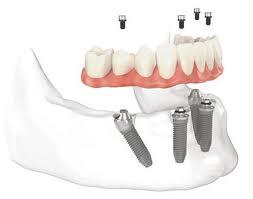This article traces the development of the procedures used to give toothless patients a new set of non-removable teeth using dental implants.
 Dental implants as we know them today have been around for several decades and for as long as they have, dentists have been trying to find a way to offer edentulous (toothless) and near-edentulous patients fixed tooth replacement solutions. The problem is, the more dental implants you surgically place, the more complicated the procedure becomes and the greater the chance of implant failure. Other problems include the cost of such a procedure, the physical toll it takes on the body and the amount of time it requires for patients to get a new set of teeth again. In the end, removable dentures - as uncomfortable and difficult as they can be to live with - just seem to be the better option!
Dental implants as we know them today have been around for several decades and for as long as they have, dentists have been trying to find a way to offer edentulous (toothless) and near-edentulous patients fixed tooth replacement solutions. The problem is, the more dental implants you surgically place, the more complicated the procedure becomes and the greater the chance of implant failure. Other problems include the cost of such a procedure, the physical toll it takes on the body and the amount of time it requires for patients to get a new set of teeth again. In the end, removable dentures - as uncomfortable and difficult as they can be to live with - just seem to be the better option!
Then, news of the “All-on-4” dental implant protocol was announced to the world.
In the Beginning, there was Osseointegration
In 1951, Swedish orthopedic surgeon - Per-Ingvar Brånemark - accidentally stumbled across the key that would lead to the conception of the entire field of dental implantology: ‘osseointegration’. It was during a clinical trial using rabbit bone that the professor noticed the complete bio-compatibility of titanium. Instead of being rejected by the body as most foreign materials are, the bone had actually biologically bonded to the surface of the titanium.
Eureka!
It wasn’t long after that the first dental implants were constructed from titanium metal and successfully used to replace teeth. As the years passed, ceaseless research and clinical trials expanded upon the academic understanding behind and practical application of dental implants as a tooth replacement solution. But still… while dental implant dentists could replace one or more missing teeth quite successfully, those who had lost all of their teeth faced a long and painful journey to oral rehabilitation.
Design and Development of “All on 4” Dental Implants

Just think about it: you have 32 teeth in your mouth; 28 minus your wisdom teeth. Can you imagine replacing every single one with dental implants? Can you image the scope of the surgery required to give an edentulous patient a complete set of teeth back?
Such a procedure just isn’t viable, so instead of replacing every single missing tooth with an implant, oral surgeons would use up to 10 dental implants per jaw to provide support for a non-removable prosthetic dental bridge (an artificial set of teeth). Yet still, 10 implants per jaw can require many separate surgeries to place and the expense of such an endeavor costs a considerable amount of time and money.
It was only in the early 1990’s that a protocol, which only required four dental implants per jaw to support a full set of replacement teeth, was developed and clinically tested. This protocol became termed the “All-on-4”. What further set this procedure aside from traditional dental implant procedures was that it was designed to, as far as possible, bypass the need for bone grafting surgery, thus saving patients many months of recovery, tens of thousands of dollars on the cost of surgery and a whole lot of pain and discomfort.
“All on 4” Implants, Here, Today

Nowadays, more and more dentists are receiving the necessary training in what is increasingly becoming regarded as a fundamental rehabilitative dental procedure. And when you consider that All on 4 dental implants in Houston are able to give people a brand new set of teeth in as little as a single day, with a single surgery and at costs that are an average $25,000 lower, it’s no wonder why!
No comments:
Post a Comment